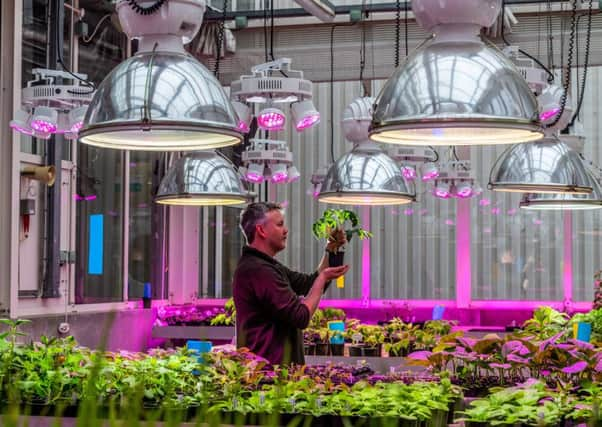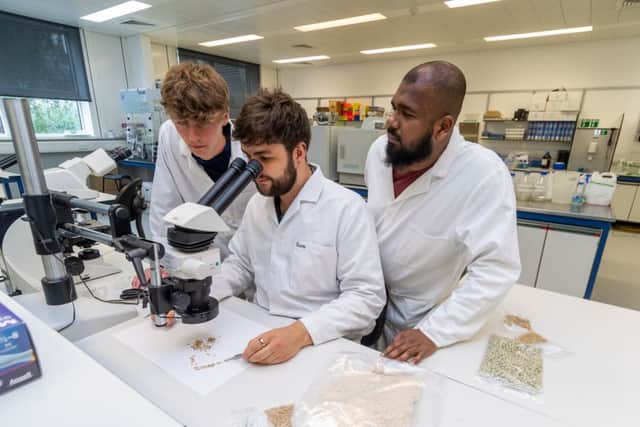Science hub grows Yorkshire’s bioeconomy – and stem the flow of graduates heading south


In fact, one study last year concluded that it had been going on for at least two centuries and was a major reason for the creation of the economic north-south divide.
What’s more, although Yorkshire is very good at attracting and educating young people to extremely high standards, it appears to be rather bad at keeping hold of them, and it even struggles to lure back its own native sons and daughters once they’ve graduated elsewhere.
Advertisement
Hide AdAdvertisement
Hide AdIt’s logical to conclude that if nothing is done to stop the North’s finest grey matter from leaking southwards, then the UK’s current disparities in wealth and productivity look set to stick around for another 200 years.


Which means that any attempt to redress the national balance and create a Northern Powerhouse must tackle the issue.
Fortunately, some of the country’s finest minds are on the job.
Surrounded by fields and woodland in the Vale of York, the National Agri-Food Innovation Campus (NAFIC) is a collection of large, white buildings on an 80-acre parkland site near Sand Hutton, north-east of York.
Advertisement
Hide AdAdvertisement
Hide AdIts 15 tenants include SMEs, such as Abingdon Health, Mologic and Symbiosis; large companies like Covance and Fera; and government agencies, such as Public Health England, the Animal & Plant Health Agency, and the Department for Environment Food & Rural Affairs (Defra).


Over 850 people work here on research into subjects as diverse as the decline in insect pollinators, the management of aircraft birdstrikes, and the creation in the lab of human skin for pharmaceuticals and cosmetics testing.
It is a major contributor to Yorkshire’s bioeconomy, which is estimated to be worth £8.7bn in GVA terms. But, with the Government having stated its aim of doubling the size of the North’s bioeconomy, NAFIC is thinking big.
“A lot of students get work experience with us and then move to London and places like Oxford and Cambridge, where there is a lot of help for science start-ups,” says Robert Watts, European apprenticeship and talent programme manager for Covance.
Advertisement
Hide AdAdvertisement
Hide Ad“So one of the things we’ve done to address that is a massive push to improve access to apprenticeships for school-leavers. Two years ago we had two apprentices; now we have more than 100 and a lot more will be starting later in the year.”
Covance currently offers apprenticeships for laboratory technicians, laboratory scientists, business administrators, project management assistants, leadership and management, chartered managers, MBA, healthcare practitioners and customer service, but it plans to add more, such as medical statistics, quality management and even nursing.
And the company is not going it alone; its neighbour, Fera, currently has eight apprentices – six lab technicians and two lab scientists – and aims to add more subjects, such as marketing and IT.
Now the two companies have come together in partnership with the campus and regional education providers to create a training hub for the next generation of talent.
Advertisement
Hide AdAdvertisement
Hide AdLeeds City College is delivering the Level 4 (A level equivalent) lab technician apprenticeship for Fera and Covance, and York St John University is delivering the Level 6 (degree equivalent) apprenticeship.
Fera is keen on extending to Level 7 (masters), and Covance is looking at a way to extend it to doctorate level, meaning that a school-leaver could get a job on the campus and end up with a PhD – while being paid to do their job.
But this is just the start. The partners now want to develop the hub into a formal entity: the National Science Training Centre (NSTC).
It is hoped that by offering an alternative to traditional educational provision in science, which all too often produces graduates who still don’t know how laboratories work, the centre can deliver what the employers need, when they need it.
Advertisement
Hide AdAdvertisement
Hide Ad“It makes sense that a like-minded group of employers, particularly in the science sector, come together to do that,” says Philippa Hobby, business support manager at Fera.
“It’s also about local links, right down to school level, so that we have a recruitment pipeline.”
On-site scientists could be guest lecturers, courses could run through the summer, the region’s science teachers could be involved in enthusing school-leavers, and a CPD [continuing professional development] element could be added.
“The centre is going to be about getting employers together who share similar issues in terms of being able to recruit specific skills,” says Liz Cashon, NAFIC’s innovation campus manager.
Advertisement
Hide AdAdvertisement
Hide Ad“More narrowly, in STEM, we have national graduate shortages in things like bio-informatics, combining IT with chemistry and biology, and being able to understand and interpret the data.
“If 10 employers in this region all need five people with those skills, if they collectively come together and say ‘we want one of the training providers to provide this as a higher-level apprenticeship so we can grow our staff on-site’, then I think that’s where the training centre can play a major role.”
The NSTC is currently a virtual entity, without any bricks-and-mortar presence, but it’s hoped that will change.
“We would love to see an actual physical academy established, ready to go for the next academic year intake, which would be September 2020,” says Ms Cashon.
Advertisement
Hide AdAdvertisement
Hide AdBut for the NSTC to take off it will need a critical mass of students, and that means more companies getting involved.
“We’re looking for partners from the corporate world, SMEs that need those kinds of science skills,” she says.
“If we were going to be running a centre here full-time we’d probably need 50 to 60 students going through it in a year, so we probably need another three or four big employers or 10 SMEs – not huge numbers – to make it viable.”
The York, North Yorkshire and East Riding Enterprise Partnership (LEP) has ploughed considerable investment into helping NAFIC double in size by 2021, and Anabel Jelley, head of business and skills, is keen to see more companies commit to the NSTC.
Advertisement
Hide AdAdvertisement
Hide Ad“We’ve got full employment, so we haven’t got people just floating around waiting to fall into a job,” she says.
“It’s a problem across the board. You do get employers who seem to think there are people just waiting to fall into the roles and they don’t have to do anything themselves.
“But if you’re serious about being part of the solution, then get involved with apprenticeships, internships and training.”
Covance’s Robert Watts needs no persuasion, and thinks the centre could combat the brain drain in two ways: by recruiting homegrown scientists who won’t want to leave the area, and by attracting new employers to the region.
Advertisement
Hide AdAdvertisement
Hide AdHe says: “If we can take people from the local community and give them the chance to fulfil their aspirations, they’re more likely to stay – far more so than graduates from other parts of the country who have no connection to the area.
“We can use our size to help other companies and they can join our programmes. What we want to do is increase the size of the sector across the region to encourage people to stay here. The more science training is seen as being good here, the more companies are likely to move here.”
Ultimately, the project is about getting talent to stay in the region, so it’s the young trainees who need to be convinced that their future lies in Yorkshire.
Liz Cashon has a message for them: “Don’t think that there aren’t opportunities to progress to the highest pinnacle of your career in the region, because there definitely are. We’ve got the chief plant health officer for the whole government here – she works in an office down the corridor – and that’s the highest you can possibly get in that arena. So there are opportunities like that – you just need to go out and find them.”
HISTORY OF THE BRAIN DRAIN
Advertisement
Hide AdAdvertisement
Hide AdThe brain drain is not a new problem. A 2018 report by the Centre for Economic Policy Research (CEPR) concluded that it had been going on for at least 200 years and was a major reason for the creation of the economic north-south divide.
Using information on surnames that were northern or southern in origin in pre-industrial England, university professors Gregory Clark and Neil Cummins found evidence of significant migration of those with talent from the North to the South over the last couple of centuries.
They found that those with northern surnames in the South amounted to an “economic elite”, with a higher rate of enrolment at Oxford and Cambridge compared with their southern peers and a “very similar pattern” seen among doctors registered since 1940. The northerners – and their descendants – living in the South even have higher house values than their neighbours and more wealth upon death.
By contrast, the report found the opposite to be true of those from the South who have headed north over the last 200 years, suggesting an inverted version of the brain drain.
Advertisement
Hide AdAdvertisement
Hide Ad“Migrants out of the north have had high abilities, and migrants into the north low abilities,” it says.
The researchers suggest that one reason for this is that the staple industries of the North – textiles, coal, iron, and shipbuilding – demanded relatively unskilled labour, whereas the white-collar jobs in the South demanded higher levels of skills and education. In other words, “the unskilled moved North, and the skilled to the South”.